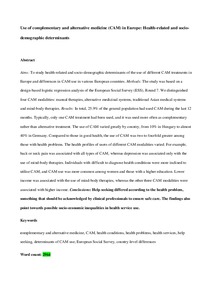Use of complementary and alternative medicine in Europe: Health-related and sociodemographic determinants
Kemppainen; L.; T. Kemppainen; J. Reippainen; S. Salmenniemi & P. Vuolanto
https://urn.fi/URN:NBN:fi-fe2021042717695
Tiivistelmä
Aims: The aim of this research was to study health-related and sociodemographic determinants of the use of different complementary and alternative medicine (CAM) treatments in Europe and differences in CAM use in various European countries. Methods: The study was based on a design-based logistic regression analysis of the European Social Survey (ESS), Round 7. We distinguished four CAM modalities: manual therapies, alternative medicinal systems, traditional Asian medical systems and mind-body therapies. Results: In total, 25.9% of the general population had used CAM during the last 12 months. Typically, only one CAM treatment had been used, and it was used more often as complementary rather than alternative treatment. The use of CAM varied greatly by country, from 10% in Hungary to almost 40% in Germany. Compared to those in good health, the use of CAM was two to fourfold greater among those with health problems. The health profiles of users of different CAM modalities varied. For example, back or neck pain was associated with all types of CAM, whereas depression was associated only with the use of mind-body therapies. Individuals with difficult to diagnose health conditions were more inclined to utilize CAM, and CAM use was more common among women and those with a higher education. Lower income was associated with the use of mind-body therapies, whereas the other three CAM modalities were associated with higher income. Conclusions: Help-seeking differed according to the health problem, something that should be acknowledged by clinical professionals to ensure safe care. The findings also point towards possible socioeconomic inequalities in health service use.
Kokoelmat
- Rinnakkaistallenteet [27094]
